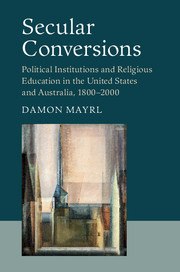 Secular Conversions
Secular Conversions Book contents
- Frontmatter
- Contents
- List of Figures and Tables
- Acknowledgments
- List of Acronyms
- Introduction
- 1 Politics, Institutions, and Secularization
- Part I Forging the nineteenth-century settlement
- Part II The nineteenth-century settlement in transition
- Part III Forging the twentieth-century settlement
- Part IV Implications
- Epilogue: Toward a Twenty-First-Century Settlement?
- Index
Part III - Forging the twentieth-century settlement
Published online by Cambridge University Press: 05 August 2016
- Frontmatter
- Contents
- List of Figures and Tables
- Acknowledgments
- List of Acronyms
- Introduction
- 1 Politics, Institutions, and Secularization
- Part I Forging the nineteenth-century settlement
- Part II The nineteenth-century settlement in transition
- Part III Forging the twentieth-century settlement
- Part IV Implications
- Epilogue: Toward a Twenty-First-Century Settlement?
- Index
Summary
The previous part of the book dealt with the dynamics of religion and education under the aegis of the nineteenth-century settlement, focusing on how administrative institutions helped to advance or retard two key secularizing processes, professionalization and religious conflict. As we have seen, the period between 1870 and 1945 saw the slow decline of devotionals in American public schools as religious outsiders and educational professionals took advantage of decentralized administration to implement more secular policies. And it also saw the persistence of religious instruction in Australian schools, as centralized administrative structures stymied efforts either to challenge from without, or to transform from within, the educational policies established in the late nineteenth century.
Part III takes up the story from 1945 onwards, to explain why American and Australian secular settlements diverged in the mid-twentieth century. To do so, it focuses on the process of religious conflict, and how it interacted with the institutional terrain in each country. The dynamics of religious conflict changed significantly at midcentury, as the longstanding Protestant–Catholic divide began to break down in both countries. As it did, new alliances began to form around religious education, generating new political pressures that contributed to the emergence of new settlements in each country. In the United States, the new twentieth-century settlement featured the “strict separation” of church and state, which rejected both public aid to religious schools and public school devotionals. In Australia, by contrast, the new twentieth-century settlement embraced a version of “neutrality” that permitted both public aid (“state aid”) to religious schools and devotional religious exercises in the public schools.
While religious conflict was central to the emergence of both of these settlements, the institutional settings in which religious education policy was renegotiated varied. In the United States, strict separation was promulgated through the courts, which effectively nationalized what had been a fragmented and fundamentally local policy toward religion. Meanwhile, the new Australian settlement was worked out through traditional parliamentary processes, thanks to peculiar features of Australia's electoral institutions.
Part of the reason that settlement change was determined by the courts in the United States, but the legislature in Australia, was that these institutions were differently available to those political forces who were most active in defining the terms of the new settlements.
- Type
- Chapter
- Information
- Secular ConversionsPolitical Institutions and Religious Education in the United States and Australia, 1800–2000, pp. 157 - 158Publisher: Cambridge University PressPrint publication year: 2016
